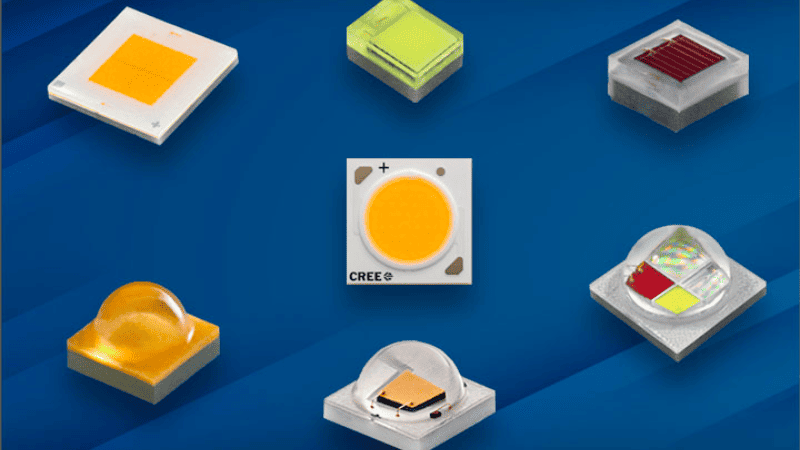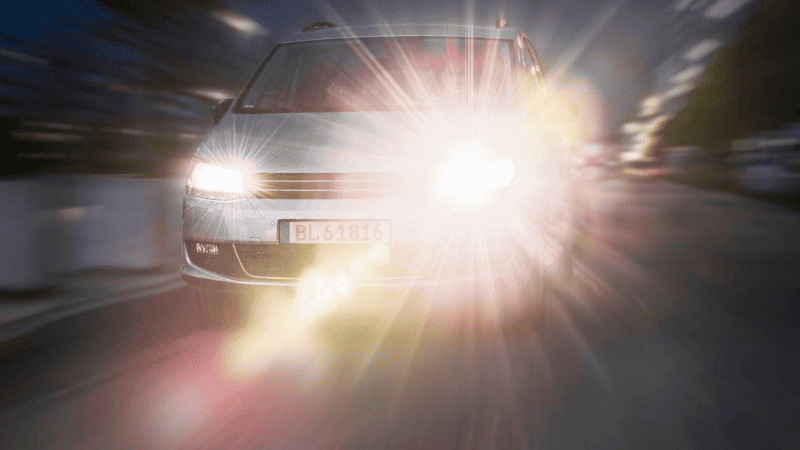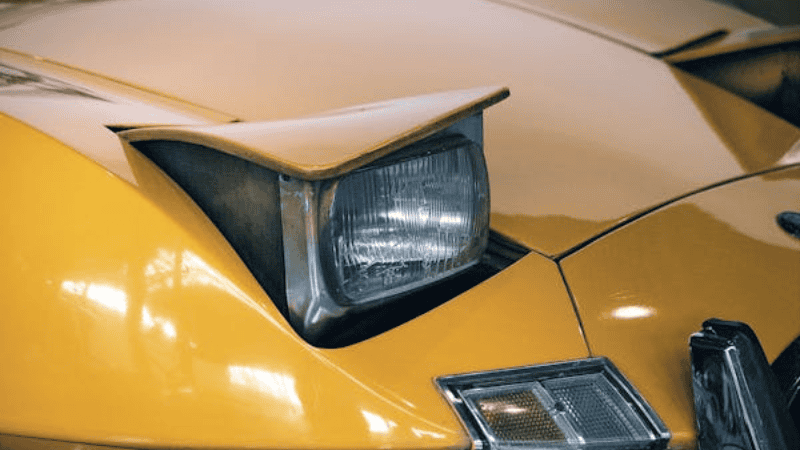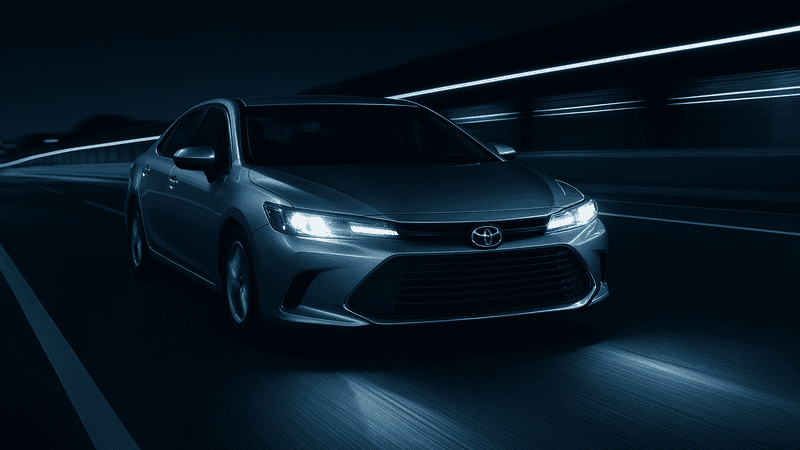From halogen bulbs and adaptive driving beams to the specific legalities surrounding aftermarket LED bulbs for vehicles, we will shed light on the complex world of LED. We navigate through the complex regulations, exploring the impact of LED technology on other drivers and road users to ensure that your vehicle meets both performance standards and safety requirements.
Basics of LED Headlights
Before exploring the inner workings of LED headlights, let’s first understand their basic components.
How LED Headlights Work?
LED headlights, a significant advancement in automotive lighting, have transformed the way we illuminate the road ahead. Unlike traditional halogen bulbs that use a filament heated by electrical current, LED (Light Emitting Diode) headlights operate through a more efficient process. They function by passing a current through a semiconductor, which then emits light. This technology allows for a more controlled and precise light output.

LED bulbs are made up of small diodes, often referred to as LED chips. These chips are responsible for the characteristic bright, crisp light of LED headlights. The design of the headlight housing also plays a crucial role in directing the beam pattern, ensuring optimal visibility without dazzling other drivers. This is particularly important in preventing blinding glare to oncoming traffic.
LED technology has also made its way into other vehicle lighting systems, including fog lights, brake lights, and other reflective devices. These advancements in LED headlights and associated equipment are continually shaping the future of vehicle lighting.
Benefits of Using LED Headlights
The shift from halogen bulbs to LED headlight bulbs in recent years has brought many advantages. One of the primary benefits is their energy efficiency. LEDs require less power to operate, translating to less strain on a car’s electrical system and potentially longer battery life. This efficiency doesn’t compromise their brightness; in fact, LEDs are known for their higher intensity and brightness compared to traditional halogen lights.

Durability is another significant advantage. LED bulbs, unlike halogen bulbs that contain fragile filaments, are more robust and less prone to damage from vibrations and shocks, making them a suitable choice for all types of vehicles, from everyday cars to commercial vehicle industries.
Furthermore, LED headlights provide improved visibility for drivers. The whiter light of LEDs resembles daylight more closely than the yellow hue of halogen lamps, enhancing night vision and making it easier to spot obstacles and other road users.
Legal Regulations for Vehicle Headlights
When it comes to the legality of LED headlights for road use, regulations can vary widely across different regions, making it a complex landscape for drivers and manufacturers to navigate.

In the United States, the National Highway Traffic Safety Administration sets standards for vehicle lighting, including aspects like brightness, color, and beam pattern. LED headlights must adhere to these standards to be legal. It’s also important that the beam pattern of LED headlights is designed to light up the road without causing discomfort to other drivers. The color temperature of these headlights is usually regulated to emit white light to maintain consistency and avoid confusion for other drivers.
In California, specific regulations address the brightness and glare of headlights to ensure they do not blind other drivers. Aftermarket LED headlight bulbs must be marked “DOT” to indicate compliance with federal regulations, specifically the Federal Motor Vehicle Safety Standard (FMVSS) No. 108, which sets standards for headlight brightness and beam pattern.
The UK’s regulation of LED headlight bulbs is governed by the Road Vehicles Lighting Regulations 1989, which specify technical requirements for all lighting equipment on vehicles, including headlight bulbs. These regulations require that headlight bulbs comply with specific standards concerning performance, construction, and dimensions, including their photometric characteristics.
In India, the Central Motor Vehicle Rules (CMVR) allow the use of LED headlights provided they meet certain specifications prescribed in the Indian Standards for automotive lighting. The headlights should not cause glare or dazzle other road users and must be properly aligned.

In the Philippines, the regulation of LED headlight bulbs falls under the jurisdiction of the Land Transportation Office (LTO), which issues guidelines specifying technical requirements based on the Philippine National Standard. The color temperature of LED headlights should be between 4,000 and 6,000 Kelvin, and their brightness should not exceed 5000 lumens.
Drivers and manufacturers need to stay updated with these regional laws to ensure compliance and contribute to the safety of all road users.
Specifics of LED Headlight Regulations
As we examine the specific regulations governing LED headlights, it’s crucial to focus on key factors like brightness and beam patterns.
Brightness and Beam Pattern Standards
Beam pattern and brightness guidelines are two significant aspects of regulation for LED headlights. These standards are in place to ensure that LED headlights are road-legal and safe for all public road users.
The brightness of LED headlights is often a focal point in regulation discussions. In many regions, there’s a maximum lumen output for headlights to prevent excessive glare, which can be hazardous to other drivers, especially at night. For instance, the Federal Motor Vehicle Safety Standard No.108 in the United States caps headlight brightness at 3,000 lumens.

Equally important is the beam pattern of the LED headlight unit. The beam pattern must be designed in such a way that it illuminates the road ahead effectively without causing blinding glare to oncoming traffic. This requirement ensures that LED headlight bulbs, whether they’re factory-fitted or aftermarket LED replacements, do not endanger oncoming drivers or pedestrians. Regulations often mandate that the beam pattern should not scatter light but should be well-focused to enhance visibility without causing discomfort to others.
Color Temperature Restrictions
Color temperature is another crucial aspect of LED headlight regulations. LED headlights are required to emit a specific color of light, generally within the white light spectrum. This is typically measured in Kelvin (K). Regulations usually stipulate a color temperature range, often between 5000K and 6000K, to maintain a standard that is safe and does not cause distractions on the road. This standardization aims to avoid the use of LED bulbs that emit light with high color temperatures, like blue or xenon, which can be harsh on the eyes and potentially hazardous.

These regulations are in place to ensure the safety of all road users, including drivers, pedestrians, and cyclists. It’s crucial for drivers considering upgrading to LED headlights, whether for better night vision or a brighter light output, to choose products that comply with these legal requirements to avoid penalties and ensure safe driving conditions on public roads.
Importance of Choosing Legal LED Headlights
The risks associated with using illegal headlights in your car are significant and multifaceted. Firstly, legal compliance is crucial. Using illegal bulbs in your car’s headlamps can result in penalties, fines, or even the failure of your vehicle to pass inspections. Legal regulations are in place for a reason, primarily to ensure safety on the road. When you replace your car’s original bulbs with illegal aftermarket bulbs, you’re not just risking a fine; you’re potentially compromising the safety of your vehicle.
One major risk is related to the reflector and beam pattern of the headlamps. Cars are designed with specific types of bulbs in mind. If you replace a halogen bulb with an illegal LED or HID bulb, the reflector in the headlamp might not work properly with the new bulb. This mismatch can lead to a poorly focused beam pattern, which is not only less effective but can also be dangerous. It might cause glare that can blind other drivers, significantly increasing the risk of accidents.

The brightness of illegal bulbs often exceeds legal limits. Excessively bright bulbs can dazzle other road users, leading to dangerous driving conditions, especially at night. While the goal might be to have brighter headlights for better visibility, using bulbs that are too bright can have the opposite effect, creating blind spots for other drivers and reducing overall safety.
Furthermore, replacing bulbs with non-compliant ones can impact the energy efficiency and power consumption of your car. Legal bulbs are designed to operate within the car’s power capabilities, ensuring that the vehicle’s electrical system isn’t overloaded. Illegal bulbs might draw more power than the car is designed to handle, potentially leading to electrical issues or even damage.
How to Choose a Headlight Manufacturer
Selecting the right manufacturer for your car’s LED headlights is crucial to ensure you get quality, legal, and reliable products. Here are key points to consider:
- Legal Compliance: Ensure the manufacturer produces bulbs that are legal for road use. Legal bulbs meet all regulatory standards for brightness, beam pattern, and color. The manufacturer should provide clear information on whether their bulbs are compliant with regional vehicle lighting laws.
- Quality of Bulbs: High-quality bulbs ensure longevity and better performance. A good manufacturer will offer bulbs that consistently emit bright, clear light without flickering or dimming over time. Look for bulbs that are designed to work efficiently with your car’s power system, avoiding any unnecessary strain on the energy resources of the vehicle.
- Compatibility with Your Car: Not all LED or HID bulbs will work with every car’s headlamp and reflector design. A reputable manufacturer will provide detailed information on which cars their bulbs are compatible with. This ensures that when you replace the original bulb, the new one fits perfectly and works in harmony with your car’s headlamp reflector.
- Customer Reviews and Reputation: Check customer reviews and research the manufacturer’s reputation. Positive feedback from other car owners can be a good indicator of the reliability and quality of the bulbs.
- Warranty and Support: A trustworthy manufacturer stands behind their products with a solid warranty and customer support. This shows confidence in their product’s quality and provides peace of mind for your purchase.
When selecting a manufacturer for your vehicle’s headlights, it’s crucial to focus on those that offer replaceable bulbs compliant with legal standards. These high-quality bulbs should enhance the performance of your vehicle’s lighting, replacing traditional halogen gas bulbs with bright, energy-efficient alternatives.
Whether for on-road use or off-road adventures, the right bulb can provide enhanced visibility and safety. Additionally, consider options like fog lights to further improve your driving experience in various conditions. Opting for legally compliant and superior quality bulbs ensures your vehicle’s headlamps are not just replaced but significantly upgraded.
Conclusion
Understanding the legality and importance of LED headlights for road use is crucial for both safety and compliance. It’s essential to choose legal, high-quality LED headlight bulbs and ensure they are compatible with your car’s headlamp system. By selecting the right manufacturer and adhering to legal standards, you not only enhance your driving experience but also contribute to safer roads for everyone.
Why Choose Carlightvision for Your LED Headlights?
Step into a brighter future with Carlightvision’s superior LED headlights. Our products offer the perfect combination of style, efficiency, and safety, ensuring your vehicle stands out for all the right reasons. With Carlightvision, you’re not just upgrading your car’s lighting; you’re enhancing your entire driving experience. Embrace the innovation and quality that Carlightvision brings to every journey. Visit our website to explore our product catalog, or contact us today to discover how our advanced lighting solutions can illuminate your path.




